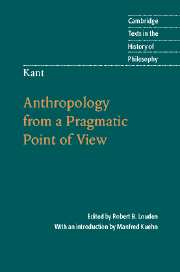Book contents
- Frontmatter
- Contents
- Introduction
- Chronology
- Further reading
- Note on the text and translation
- Anthropology from a Pragmatic Point of View
- Preface
- Contents
- Part I Anthropological Didactic. On the way of cognizing the interior as well as the exterior of the human being
- Part II Anthropological Characteristic. On the way of cognizing the interior of the human being from the exterior
- A The character of the person
- B The character of the sexes
- C The character of the peoples
- D The character of the races
- E The character of the species
- Index
- Cambridge Texts in the History of Philosophy
D - The character of the races
Published online by Cambridge University Press: 05 June 2012
- Frontmatter
- Contents
- Introduction
- Chronology
- Further reading
- Note on the text and translation
- Anthropology from a Pragmatic Point of View
- Preface
- Contents
- Part I Anthropological Didactic. On the way of cognizing the interior as well as the exterior of the human being
- Part II Anthropological Characteristic. On the way of cognizing the interior of the human being from the exterior
- A The character of the person
- B The character of the sexes
- C The character of the peoples
- D The character of the races
- E The character of the species
- Index
- Cambridge Texts in the History of Philosophy
Summary
With regard to this subject I can refer to what Herr Privy Councilor Girtanner has presented so beautifully and thoroughly in explanation and further development in his work (in accordance with my principles); I want only to make a further remark about family kind and the varieties or modifications that can be observed in one and the same race.
Instead of assimilation, which nature intended in the melting together of different races, she has here made a law of exactly the opposite: namely in a people of the same race (for example, the white race), instead of allowing the formation of their characters constantly and progressively to approach one another in likeness – where ultimately only one and the same portrait would result, as in prints taken from the same copperplate – rather to diversify to infinity the characters of the same tribe and even of the same family in physical and mental traits. – It is true that nurses, in order to flatter one of the parents, say: “The child has this from the father, and that from the mother”; but if this were true, all forms of human generation would have been exhausted long ago, and since fertility in matings is regenerated through the heterogeneity of individuals, reproduction would have been brought to a standstill. – So, for example, ash-colored hair (cendrée) does not come from the mixture of a brunette with a blond, but rather signifies a particular family kind.
- Type
- Chapter
- Information
- Kant: Anthropology from a Pragmatic Point of View , pp. 223 - 224Publisher: Cambridge University PressPrint publication year: 2006



